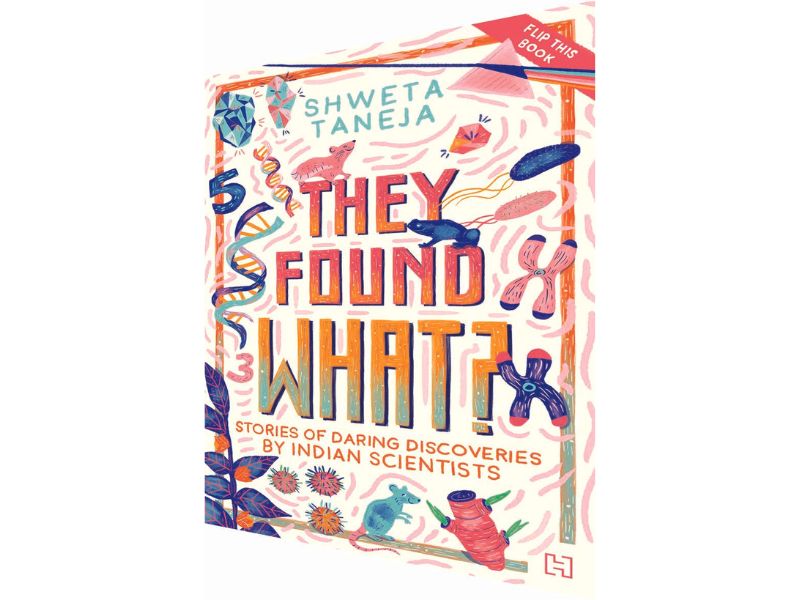THEY FOUND WHAT? STORIES OF DARING DISCOVERIES BY INDIAN SCIENTISTS
THEY MADE WHAT? STORIES OF INGENIOUS INVENTIONS BY INDIAN SCIENTISTS
Shweta Taneja; HACHETTE INDIA; Rs.399; 288 pp
HERE’S A welcome addition to popular-science writing for children in India. Shweta Taneja, the author, is passionate about familiarising children with the wonders of modern science and scientists, and has been doing so effectively. She has won several awards for her books and the one under review has been much appreciated as well.
They found what? comprises 20 stories of Indian scientists pursuing their chosen fields and successfully overcoming barriers to arrive at their eureka moment. Most of these scientists are alive today and working. Through this book, Taneja has made contemporary science research in India accessible to young readers and adults, something to be welcomed.
They found what? All types of things! Sanjeev Das, a biochemist, found ways to eliminate cancer cells; Manindra Agrawal, a professor at IIT-Kanpur, succeeded in making an equation for primality testing (something that had long eluded mathematicians); S.P. Vijayakumar, an ecologist discovered a frog that established a whole new genus, and so on.
They made what? Again, a whole lot of things and much of it at a microscopic level: Ramgopal Rao made an electronic dog using nanotechnology to sniff out bombs; Divya Mudappa created a rainforest in the middle of a tea estate; Sonam, an engineer, discovered ice glaciers to solve Ladakh’s water woes, and so on.
The biggest challenge in writing a book about scientific advances is to make it interesting to capture the imagination of children. Moreover, in a world flooded with scientific information on the internet, one has to write a book that offers something more than a dry compilation of facts. Thankfully, this book is more than a description of scientific breakthroughs and achievements; it is also about the people who made them happen.
How does a child get interested in an idea and decide to follow it for the rest of her life? How does she find the path that would take her to fulfill her aim? How does the world help people who have a dream to follow? It is these questions that propel the reader towards an exciting finish. The author knits together the personalities of these scientists with their backgrounds and culture to create stories with rich human interest. At times, her prose becomes lyrical and evocative, which is unusual in non-fiction.
For instance, “mathematics was an old haveli to Manindra. He would be sitting in a room full of people and his brain would fling open the door to an unused room, filled with images of equations, numbers, symbols and signs. A fresh idea or equation would beckon him as he stepped into the room, following its trail.”
Although the author has tried to keep the narration free from jargon, the text becomes challenging in parts. It assumes that the reader has a certain level of knowledge and familiarity with scientific terminology and concepts, which may not be the case. To be fair, annotations are plentiful, but the challenge remains.
Additional and interesting information related to the topic in his/her hand is boxed and liberally scattered throughout the book. While this intent is good, it impedes the flow of the narrative. Perhaps, the information could have come at the end of each story. Activities that help children to understand complex scientific concepts and engage with them creatively also abound. However, too many activities and boxes are distracting.
The editor and author have made a spirited attempt to make the book light and engaging by inserting humour through Batty Cat Cracks and Horrible Haiku. But these two elements don’t match the level of the scientific content, being more apt for a younger reader. Foxy Facts on the other hand fit in.
One of the challenges of writing about contemporary scientists is that their work may be questioned tomorrow. To the author’s credit, she has taken the challenge. Several scientists who feature in the book have been recipients of awards like the Shanti Swaroop Bhatnagar and Infosys awards. It’s good for young readers to learn about these honours bestowed in India.
People who research children’s literature are increasingly opining that more non-fiction should be included in children’s reading lists, as it is as engaging as fiction. “Children want non-fiction books, adults may be their barriers,” says Heather Simpson, chief program officer of Room to Read.
Non-fiction engages children with the real world which is exciting for them. For this reason, more books such as They made what? should be written for children.
NEERA JAIN (The Book Review)
